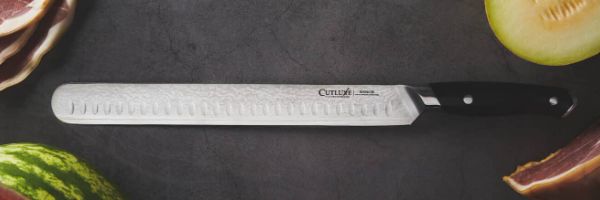Brisket, a cut of meat from a cow’s breast or lower chest, has become a staple in many barbecue menus. Its juicy and tender texture makes it a crowd-pleaser at any gathering but cutting it can be a daunting task. Using the right knife for the job is crucial in achieving perfectly sliced brisket. In this blog post, we will discuss the importance of using the right knife to cut brisket and provide an overview of the different types of knives suitable for the task. So, whether you’re a seasoned pitmaster or a beginner, keep reading to learn more about the brisket-cutting essentials and find out what knife to use to cut brisket.
Different Types of Knives to Cut Brisket
When it comes to cutting brisket, there are a variety of knives to choose from, each with its unique advantages.

A slicer knife is a long, thin blade that is perfect for cutting thin slices of brisket. This knife is great for achieving consistent thickness in each slice.

A chef’s knife, on the other hand, has a wider blade that is useful for both slicing and chopping.

A cleaver is a heavy, rectangular knife that is great for breaking down larger cuts of meat, including brisket. Its weight allows it to easily chop through bones and cartilage.
Finally, an electric knife is a handy tool for those who may have difficulty using a traditional knife due to physical limitations. The electric knife’s motor makes it easy to slice through even the toughest cuts of meat, including brisket.
Factors to Consider When Choosing a Knife to Cut Brisket
Choosing the right knife for brisket can be a daunting task, but considering a few key factors can make the decision easier.
Knife Length: The length of the blade is an important consideration. A blade that is too short may not be able to make clean, even slices, while a blade that is too long may be difficult to control. The ideal blade length for a brisket knife is usually between 10 and 12 inches.
Blade Flexibility: Another important factor to consider is the blade’s flexibility. A flexible blade can help to maneuver around bones and other obstacles, while a stiffer blade is better suited for slicing through thicker, tougher pieces of meat.
Material: The material of the blade is also important, with high-quality stainless steel being a popular choice for its durability and ease of maintenance.
Comfort: The comfort of the handle should not be overlooked, as a knife that is uncomfortable to grip can lead to hand fatigue and make the task more difficult than it needs to be. A handle with a good grip and ergonomic design can make the process of slicing brisket a breeze.
How to Use a Brisket Knife
When using a brisket knife, there are several important techniques to keep in mind to achieve the best results.
First and foremost, it’s important to use a proper grip on the knife. The handle should be firmly grasped, with the index finger and thumb placed on opposite sides of the blade for maximum control.
It’s also important to cut against the grain of the meat, which means cutting perpendicular to the direction of the muscle fibers. This helps to break up the fibers and make the meat more tender.
When trimming the fat, it’s important to use a gentle touch and not remove too much, as the fat adds flavor and moisture to the meat.
A good technique is to trim the fat down to about 1/4 inch, which is enough to allow the meat to absorb seasoning and smoke, while still providing flavor and moisture.
With these techniques in mind, anyone can become an expert at using a brisket knife and achieve delicious, tender results every time.
Maintenance and care of your brisket knife
Proper maintenance and care of your brisket knife is essential to ensure its longevity and performance.

Firstly, it’s important to clean the knife thoroughly after each use to prevent any bacteria buildup. The knife should be washed with hot, soapy water and dried immediately to prevent rust or corrosion. Avoid putting the knife in the dishwasher, as the high heat and chemicals can damage the blade. Store the knife in a knife block or on a magnetic strip, making sure the blade is protected from any contact that may cause damage.
Secondly, sharpening and honing the blade is an important aspect of maintenance. Honing should be done before each use to keep the blade straight while sharpening is done less frequently to remove any nicks or dullness in the blade. Use a sharpening stone or electric sharpener to sharpen the blade, making sure to follow the manufacturer’s instructions. Honing can be done using honing steel or a ceramic honing rod, making sure to angle the blade at approximately 20 degrees and honing from the base of the blade to the tip.
By following these maintenance and care tips, you can ensure that your brisket knife remains in top condition for many years to come.
In conclusion, choosing the right knife to cut brisket is essential for achieving the best results. A good brisket knife should have a blade length that allows for consistent slices, the right amount of flexibility for maneuvering around bones, and a comfortable handle for a secure grip. Additionally, proper care and maintenance of the knife can ensure that it remains in excellent condition for many years to come. By keeping in mind the factors discussed in this article, anyone can become an expert at using a brisket knife and achieve delicious, tender results every time. We highly recommend investing in a high-quality brisket knife and taking the time to learn proper maintenance and care techniques for optimal performance.
Our Top 10 Pick The Best Knife For Cutting Potatoes (kitchenrated.com)
Top 10 Best Knife For Cutting Onions (kitchenrated.com)

Hey There, I’m Monica, Mom of two. This is my personal blog site. Here I write about Kitchen Tips Tricks, Recipes, and Review the products I use.
I hope you enjoy the article. Give me feedback on how I’m doing with my blog. I would appreciate it so much.
Have a great day! 🙂
[Follow me on Twitter]





